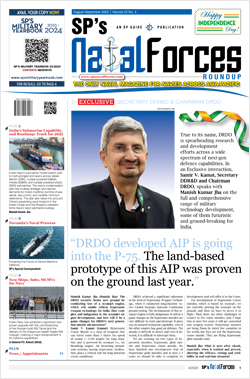INDIAN ARMED FORCES CHIEFS ON OUR RELENTLESS AND FOCUSED PUBLISHING EFFORTS

The insightful articles, inspiring narrations and analytical perspectives presented by the Editorial Team, establish an alluring connect with the reader. My compliments and best wishes to SP Guide Publications.

"Over the past 60 years, the growth of SP Guide Publications has mirrored the rising stature of Indian Navy. Its well-researched and informative magazines on Defence and Aerospace sector have served to shape an educated opinion of our military personnel, policy makers and the public alike. I wish SP's Publication team continued success, fair winds and following seas in all future endeavour!"

Since, its inception in 1964, SP Guide Publications has consistently demonstrated commitment to high-quality journalism in the aerospace and defence sectors, earning a well-deserved reputation as Asia's largest media house in this domain. I wish SP Guide Publications continued success in its pursuit of excellence.
- Operation Sindoor: Resolute yet Restrained
- Advanced MRSAM for India for a greater firepower
- Japan and India set forth a defence cooperation consultancy framework, talks on tank and jet engines
- Uri, Pulwama and now Pahalgam
- Terrorist Attack in Pahalgam in Kashmir: Unfolding a long surgical war against PAK
India's Sittwe-Chabahar Combo
With operational control over Sittwe Port in the east and Chabahar Port in the west, India strengthens its strategic presence in the region, ensuring diversified trade routes and bolstering its geopolitical stance
 |
The Author is Former Director General of Information Systems and A Special Forces Veteran, Indian Army |
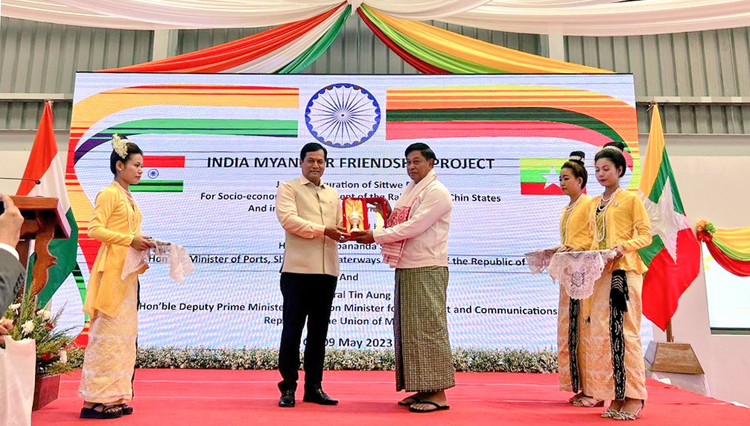
The news about India securing the rights to operate the Sittwe Port in Myanmar with full operational control by India Post Global Limited (IPGL) was shared in these columns on March 26, 2024. This was a strategic plus in India's Act East Policy (AEP). Linked with Sittwe Port is India's Kaladan Multi Modal Transit Transport Project, which connects with Paletwa via river Kaladan on the India-Myanmar border and further ahead to Lawngtlai, Mizoram by road. The Sittwe port links India's northeast, as an alternate route to the Siliguri corridor and decreases transportation cost to many areas, including landlocked Mizoram.
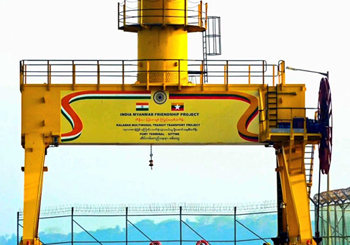
This strategic link to the North-East would relieve pressure on the Siliguri Corridor, and is expected to contribute to economic development of India's North-Eastern states by opening the sea route for their products. Taking its name from Kaladan River in Myanmar, the project will reduce the distance between Kolkata and Sittwe by 1,328 km. Sittwe in Myanmar, Chattogram and Mongla in Bangladesh, along with various land routes are being opened through Bangladesh like the recent Akhoura-Agartala train route, and extending it to Kolkata for a trans sub-continental transportation mode. It reduces distances by about 1,200 km. The land routes to Thailand are being worked out through Myanmar by the National Highway Authority of India (NHAI).
India secured full operational control of Myanmar's Sittwe Port via India Post Global Limited (IPGL), marking a strategic enhancement in India's Act East Policy
On May 13, 2024, Iran and India signed a historic deal under which New Delhi was granted the right to develop and operate the Iranian port of Chabahar on the Gulf of Oman. The Long Term Bilateral Contract on Chabahar Port Operation was signed between Indian Ports Global Limited (IPGL) of India and the Port & Maritime Organisation (PMO) of Iran, enabling operation of Shahid Beheshti in Chabahar Port Development Project for a period of 10 years.
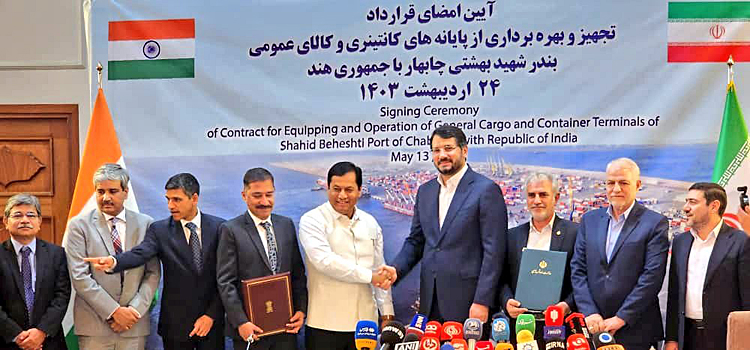
Union Minister of Ports, Shipping & Waterways and Ayush, Sarbananda Sonowal, called it a "historic moment in India-Iran ties". Iran's Minister of Roads and Urban Development, Mehrdad Bazrpash, said that under the agreement, IPGL will invest about $120 million with an additional $250 million in financing, bringing the contract's value to $370 million. External Affairs Minister S. Jaishankar said the deal "will clear the pathway for bigger investments to be made in the port".
The Kaladan Multi Modal Transit Transport Project links Sittwe Port with Paletwa and Lawngtlai, Mizoram, providing an alternative route to the Siliguri corridor and reducing transportation costs for the northeast, including landlocked Mizoram
The India-Iran deal on Chabahar was actually conceived in 2003 but did not take off for a decade plus because of US-UN sanctions on Iran related to Iran's nuclear programme. India signed a memorandum of understanding (MoU) with Iran in 2015 after the US eased sanctions on Iran following the Iran Nuclear Deal or Joint Comprehensive Plan of Action (JCPOA) agreement. In 2016, the India-Iran contract on Chabahar was executed during Prime Minister Narendra Modi's visit to Iran.
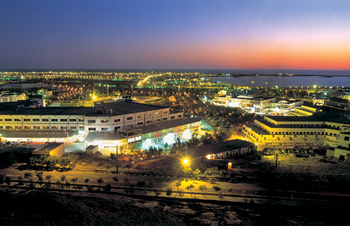
India finally began operating the Chabahar Port in end 2018. Operationalising the container terminal at Chabahar by India was delayed due to American sanctions which debarred India from procuring cranes from foreign sources. The port opened a transit route for Indian goods and products to Afghanistan and Central Asia, avoiding the land route through Pakistan. So far, 2.5 million tonnes of wheat and 2,000 tonnes of pulses have been shipped from India to Afghanistan through Chabahar Port, according to officials.
Following America's unilateral withdrawal from the Iran Nuclear Deal in 2018 and re-imposition of US sanctions on Iran, continued India-Iran cooperation raised eyebrows. But India managed to wriggle out of the US sanctions that allowed it to operate the port through ad hoc measures. However, India gave up bulk import of cheap oil from Iran next door under US pressure, which should have been resisted at least partially if not fully. Currently, China imports nearly all of Iran's 1.6 million barrels daily oil production. China defied the US sanctions but faced no US punitive action.
On May 13, 2024, India signed a historic deal with Iran to develop and operate the Chabahar Port, enabling better connectivity with Afghanistan and Central Asia by bypassing Pakistan
The Chabahar Port is critical for India's connectivity plans since it offers an alternative route to Afghanistan and Central Asia by bypassing Pakistan, allowing better trade with Central Asia and Chabahar is to be connected to the International North-South Transport Corridor (NSTC), bringing India closer to Europe through Iran, Azerbaijan and Russia. An alternative to the Suez route, a fully operational NSTC would reduce the time and money spent on intercontinental trade.
The new 10-year deal signed on May 13, 2024, serves to reset the strategic relationship between India and Iran although this is happening at a time when tensions in West Asia are high because of the Israel-Hamas war in Gaza. A day after the India-Iran deal was signed, the US State Department Deputy Spokesperson Vedant Patel said on May 14, when asked about the deal, that the US sanctions on Iran are still in place and that Washington would continue to enforce them. "Any entity, anyone considering business deals with Iran - they need to be aware of the potential risks that they are opening themselves up to and the potential risk of sanctions," he said. The same threat was also echoed by Eric Garcetti, US Ambassador to India.
Logically, the US should refrain from imposing any sanctions on India not only because of the POTUS Joe Biden has called the US-India relationship "the defining partnership of the 21st century" but also because India has already been operating the Chabahar Port through America's unilateral withdrawal from the JCPOA in 2018 and re-imposition of US sanctions. Moreover, the US needs India more as a counter to China. Also, it has now emerged that the October 7, 2023 Hamas attack on Israel was masterminded by China (not Iran) as covered separately in these columns under the title 'Tunnel Warfare'.
The Chabahar Port project, valued at $370 million, allows India to engage in trade routes that connect to the International North-South Transport Corridor (NSTC), enhancing trade efficiency with Europe
With India now operational at the Sittwe Port in the East and Chabahar Port in the West, New Delhi has a strong strategic presence on both flanks. India has been working out alternate routes in the region. India has a strong relationship with Oman and Oman has given India access to Duqm Port on the Arabian Sea.
Finally, India would need to remain on the lookout for Western efforts to destabilise Iran that could affect operations in Chabahar. Similarly, news reports of May 25, 2024, talk of 20 Indian labourers forced into slavery in Myanmar being tortured. Behind the anti-Indians wave in Myanmar, the hand of China or China-Pak is obvious, given their links with terrorist/militant organisations.





